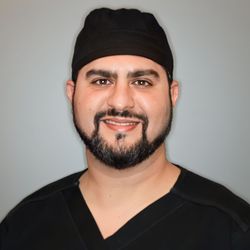Investing in dental implant therapies like single replacements or TeethXpress is one of the longest-lasting, predictable ways to replace your missing teeth. Although dental implants in The Woodlands are essentially indestructible, they still require daily hygiene and routine maintenance to ensure their success.
Here are some tips on caring for dental implant and TeethXpress restorations after your treatment is complete:
Floss Your Dental Implants Each Day
Toothbrushing is something that we rarely ever go a day without (and only in extreme situations.) But for some reason, most of us treat flossing differently. When you think about it though, brushing never cleans between your dental implants or under fixed implant restorations like TeethXpress. So, you also need to have another method to clean areas that brushing doesn’t reach.
Ideally, our implant expert in The Woodlands recommends flossing once per day. Going more than a day without dental floss means that plaque has ample opportunity to calcify into tartar. When it does, the buildup triggers gum inflammation that can potentially lead to peri-implantitis.
Without flossing, you’re missing at least 1/3 of the surface areas inside of your mouth. Even though dental implants don’t get cavities, they’re still susceptible to buildup and gum infections like your original teeth. That’s why you want to treat them as if they’re a natural part of your smile.
Use a Non-Abrasive Toothpaste
Dental implants are durable, but you ought to treat them gently. Using abrasive products such as baking soda or toothpastes with gritty textures can scratch your restorations and traumatize your gum tissues.
Stick with an ADA-approved toothpaste for brushing your implant restorations. There’s no need for special blends like whitening toothpaste or sensitivity formulas. A traditional fluoride toothpaste works fine. If you need one for tartar control, be aware that some people see more staining on their teeth with those types of products. Instead, consider booking more frequent dental cleanings.
Try to avoid DIY teeth cleaning products, as many of them inadvertently irritate your teeth or cause erosion. If you’re looking for a specific type of product, let our implant expert know; we can help you find the best toothpaste or similar oral care product that’s still safe for your smile.
Consider Using a Water Flosser
Water flossers are a great substitution for conventional floss. Especially in areas that are hard to reach or have deep gum pockets. Some studies show that water flossers reach down into periodontal pockets as deep as 6mm. In other words, they clean where flossing cannot.
Although water flossers are a little messy at first, they become easier to use the more practice you get. If the spray is a concern you may want to consider a style that works in the shower.
With a water flosser the goal is to trace along the edges of your gums and clean just under the gumlines at each dental implant. Start out with a lower pressure setting and gradually work up to stronger pressure within your individual comfort level. Stick to room-temperature water to minimize the risk of any sensitivity.
Some types of water flossers also come with interchangeable tips, including styles with tiny brushes on the ends.
Clean Underneath Dental Implant Restorations
Any smile restoration that involves multiple dental implants — such as an implant supported bridge or TeethXpress — will have areas where the restoration is suspended above your gum tissues between the implants themselves. For those spaces you’ll need to clean under your restoration to prevent infection and keep the fit as close to your gums as possible.
What’s the best way to clean under implant bridges or TeethXpress? A water flosser is likely the easiest and most efficient. Simply aim the stream of water where you want it to go and flush out any loose biofilm or food debris.
Floss threaders or tufted “super” floss are also effective. Guide the tip underneath the prosthesis, gently tugging it out on the other side. Once you have a hold on either side, slowly rub back and forth to clean underneath the appliance and around the implants on either side of the space.
Select a Soft or Extra-Soft Bristled Toothbrush
It may seem like using a stiffer toothbrush or scrubbing your teeth more aggressively is the best way to keep them clean. Unfortunately, it’s actually bad for your smile to do that. The overzealous cleaning can gradually erode your tooth enamel, abrade your dental implant restorations, and cause your gum tissues to recede (leaving your implants visible and uncovered.)
Unfortunately, there’s not a way to naturally grow back gum tissues. Rather, it’s best to prevent gum recession by forming good habits early on.
Select a soft toothbrush (manual or electric) to clean your dental implants. Only apply just enough pressure so that your gum tissues barely blanch. Anything more than this is excessive and can be traumatic to your gingiva. If it helps, hold your toothbrush with fewer fingers or in the case of an electric brush just let the bristles do all of the work for you. Eliminating pressure and excessive back-and-forth scrubbing will protect the gums responsible for holding your implants in place.
Focus on the Gums Around Your Dental Implants
Without healthy gingiva (gums), we can’t have healthy teeth and dental implants. Your TeethXpress success depends on a healthy, stable foundation for your implants underneath. That’s why daily gum care is crucial.
Each time you clean your teeth and implants, pay particular attention to the gumlines. The margins of your gums tend to be the areas where plaque biofilm forms first. Typically, there will be a heavier layer of plaque at the gumlines compared to other parts of your mouth.
Brushing and flossing should always include the edges of your gums. From slipping the floss just underneath your tissues to stimulating your gums with a toothbrush, your gingiva needs to be cleaned and oxygenated to stay healthy. Without disrupting the biofilm tucked under the gumlines, the bacteria will begin to calcify. Once they do, it’s impossible to clean the buildup off with a toothbrush and floss. In other words, focus on your gums to prevent the buildup before it starts.
Schedule Regular Dental Cleanings
Preventative dental cleanings are important for everyone, whether you still have all of your original teeth, a few dental implants, or recently restored your bite with TeethXpress. Practically any surface inside of your mouth can be prone to buildup. Even with thorough brushing and flossing, there will be microscopic amounts of plaque left behind. In time, that plaque will slowly accumulate into tartar. As the months drift by, that tartar will become visible and potentially lead to gum infections.
Scheduling a professional dental cleaning allows your hygienist to safely remove tartar buildup from your dental implants. Special instruments are used to prevent implant damage. Once all of the buildup is removed, we’ll check the gum attachment levels to ensure your implants are properly supported. Then your hygienist will gently polish away any surface stains that have accumulated since your last routine checkup.
Avoid Tartar and Stain on Dental Implants
Dental implants and TeethXpress in The Woodlands are designed to look and feel like a natural smile. Although they’re crafted from durable ceramics, porcelains, alloys, and acrylics, your dental implants and the fixed restorations can still accumulate stain and buildup.
To prevent tartar and stain deposits, it’s important to brush your implants thoroughly at least twice a day. If you’re someone who occasionally enjoys darker beverages like red wine, soda, or tea, try to rinse your mouth out with water immediately afterward. That way there’s less time for the liquid to stay in contact with your teeth.
The key to preventing tartar buildup is to disrupt plaque biofilm while it’s still soft. Since we know plaque can calcify into tartar within 24 hours, this means you’ll want to be brushing at least twice a day for two minutes at a time. Even then, there will likely be some areas that brushing will miss or can’t reach. Daily flossing and routine dental cleanings are essential too!
Reduce Your Risk of Peri-Implantitis
Knowing how to prevent peri-implantitis is one of — if not the — most important thing to be aware of when you’re getting TeethXpress or dental implants in The Woodlands. Since peri-implantitis is closely linked with periodontal disease, and it’s responsible for bone deterioration around teeth, you need to take steps to prevent it from forming from the very first day.
Symptoms of peri-implantitis include:
- Gum swelling
- Redness
- Tenderness
- Bleeding
- Bad breath
- Plaque and/or tartar buildup
Peri-implantitis is a step up from gingivitis, which occurs in areas where oral hygiene may be less than adequate. With extra areas to clean, you’ll want to have the proper resources and training to know how to keep your dental implants free of bacteria. That way there’s no biofilm present to trigger an immune response (swelling) around your dental implants. Otherwise that initial inflammatory response will evolve into physical deterioration of the bone in that immediate area.
Consider Sleeping in a Nightguard
Clenching and grinding — aka “bruxism” — isn’t something that only affects anatomical teeth. The repetitive pressure and tension can also take a toll on dental implants and your TMJ. In time, it may lead to irregular wear patterns, limited range of motion, and fractures in your implant restorations.
Protective bite splints or night guards are custom devices that place a protective buffer between your upper and lower teeth, preventing them from fully engaging while you sleep. That way your teeth aren’t grinding together over and over, wearing down your restoration or putting too much pressure on your dental implants. Although implants are durable, they also do not have the microscopic ligaments surrounding them that add “cushion” to your natural teeth. They are permanently fused into your bone. It can be dangerous for your oral health if you grind your teeth with dental implants.
For the best level of protection, you should wear a nightguard that’s designed and fitted by your personal dental provider. It will be more durable and comfortable than anything you can buy from a retailer.
Have Your Implants Examined Regularly
Proactive dental implant care will keep your smile lasting as long as possible. If any minor concerns require attention, they can be addressed while they’re small (and before they progress into major issues.)
Implants themselves can last for decades, if not an entire lifetime. Yet the restorations on top of them can gradually succumb to repetitive biting and chewing forces. In time, you’ll want to have those restorations updated or changed out with newer ones. It may only be once every 10-15 years, but routine evaluations will help you prepare for what’s coming and what options you have. Irregular, premature wear could be a sign that you need to sleep in a bite splint to extend the expected lifetime of your implant restorations.
If You Notice Tenderness or Gum Swelling Around Your Implants
Gingivitis-like symptoms could indicate an infection known as peri-implantitis. The swelling, tenderness, and redness all mean that there is some type of inflammatory response in that immediate area. Normally, the swelling will be due to some type of plaque-induced infection.
Since gingivitis is the earliest stage of gum disease and it’s a type of gum disease that is most common for implant failure (peri-implantitis), it’s crucial to address symptoms early.
Re-vamp your oral hygiene routine and make sure you’re flossing well each day. If symptoms don’t subside within a week or so, you’ll want to see our implant specialist in The Woodlands right away. A professional evaluation and cleaning could be the key to preventing implant loss. If there is tartar buildup on the dental implant, the bacteria will continue to cause inflammation. There’s no way to treat this type of condition on your own.
Interproximal / “Proxy” Brushes
A great oral hygiene tool to have on hand is an interproximal brush. Depending on who you ask, these tiny interdental cleaners are also called “proxy” or “proxa” brushes. Ultimately their name reflects being able to clean the areas between teeth when there are gaps or spaces where food and plaque can accumulate.
Interproximal brushes may look like a tufted point on the end of a toothpick. Or they can be a small Christmas-tree-shaped pipe cleaner at the end of a handle. Some handles are short, others are longer like a toothbrush (where you can change the tips out, rather than dispose of the entire handle.) Their various widths and shapes make cleaning around TeethXpress and other types of dental implants easy and effective.
Proxy brushes are ideal for cleaning between restorations and gums, where the appliance is suspended over the tissues between dental implants, or against the sides of dental implants, when space allows.
What About Removable Implant Prosthetics?
Today’s high-quality implant therapies minimize the need for wearing a removable overdenture. However, some people still prefer wearing a conventional denture that’s simply stabilized over a couple of dental implants. If you’re in a removable device instead of TeethXpress, you’ll want to treat them the same way you would a traditional denture or partial. That is, remove them at night and allow them to soak in a cleansing solution. The next morning, remove the denture and clean it thoroughly with lukewarm tap water, soap, and a soft toothbrush. Clean your mouth with a soft, damp cloth (brushing any remaining teeth.) Rinse your prosthesis thoroughly and then place it back into your mouth.
Do not use chemicals or harsh abrasives to clean removable dental appliances. Occasionally, it may be necessary to soak your denture in a diluted bleach mixture, but never do so without specific directions by your dentist.
Fortunately, fixed implant options like TeethXpress never have to be taken out of your mouth!
“Can I Whiten My Dental Implants? Crowns?”
Any time you’re getting a new dental restoration — be it a filling, crown, denture, or dental implants — you’ll want to keep the color in mind. If there are surrounding teeth, we’ll work hard to match the new restoration to that same shade as closely as possible. However, if you have any intent on whitening your teeth in the future, the bleaching process should take place before the restoration is created.
why?
Because it’s not possible to whiten dental ceramics and porcelains like those used in dental implant crowns or other fixed restorations. Those materials will maintain a consistent, steady color. They cannot be bleached into a lighter shade.
Teeth whitening is something you will want to do prior to the smile design process or leading up to changing out your restorations (so that the newer ones can be made from a lighter color.)
Preventing Dental Implant Failure
The most common reasons for dental implant failure are peri-implantitis and lack of patient education about implant maintenance. Other factors like bruxism (clenching and grinding) can also play a role.
By being prepared for daily home care and how to clean your dental implants, you can reduce the chances of your implants failing or starting to loosen.
Peri-implantitis is the implant form of gum disease. It attacks the supporting tissues around your dental implants, causing gum and bone to shrink and pull back from the implant surface. As this process occurs, it essentially eliminates the structures responsible for holding the implant in place. Gradually the infection leads to implant mobility, infection, and failure.
Fortunately, routine preventative care like daily flossing and professional dental cleanings can combat peri-implantitis from the start.
If you’re someone who clenches and grinds your teeth during the day or while you sleep, consider having your dentist fit you with a night guard or bite splint. These protective splints reduce the pressure on your implants while also training your TMJ to relax.
Is TeethXpress Maintenance Different than Individual Dental Implants?
How is caring for TeethXpress any different than daily maintenance for traditional dental implants? Not a lot, actually.
Since you care for dental implants the same way you do a natural tooth, your TeethXpress daily maintenance is only different in the way you clean around the fixed hybrid appliance. In other words, you’ll adapt your toothbrush and floss to clean from different angles. Otherwise, your oral hygiene routine is practically the same.
If you had several individual implants, the floss would simply slip down between each respective tooth. Being that TeethXpress spans the width of your entire smile, you’ll need to have a few tools on hand to reach underneath, such as a water flosser or floss threader. The key is to clean the side of each of the supporting implants, as well as between your gum tissues and the appliance (where food or plaque can get hide.)
What if an Implant Restoration Comes Loose?
There are rare situations where a dental implant crown or bridge can possibly come loose. Usually it’s associated with the abutment between the dental implant and the fixed restoration. It could be that the bonding agent came loose or that the abutment itself broke. Broken abutments should be addressed by an implant expert, as specific resources will be required to safely remove the abutment without damaging the dental implant.
If you’ve had dental implant problems and need expert care, Dr. Saunders can help. Even if we are not the provider who placed your dental implant, we’re able to provide dental implant restoration services to help you get your smile back on the right track.
Working with a skilled, experienced implant specialist can help you minimize the risk of complications during your smile rehabilitation process. It’s our ultimate goal to help you enjoy a durable bite with dental implants that last the rest of your life.
TeethXpress & Implant Specialist in The Woodlands
Dr. Kip Saunders is one of the leading periodontists and dental implant experts in The Woodlands and Conroe. If you’re searching for an implant specialist with years of experience in full mouth rehabilitation, you’ve come to the right place! Dr. Saunders has transformed thousands of smiles over the past 30 years and specializes in full-arch TeethXpress dental implant therapy.
Contact us today to reserve a pressure-free exam and consultation.
Office Hours
MON - THU8:00 am - 5:00 pm
FRI8:00 am - 2:00 pm
SAT - SUNClosed
Office Hours
MON - THU8:00 am - 5:00 pm
FRI8:00 am - 2:00 pm
SAT - SUNClosed














